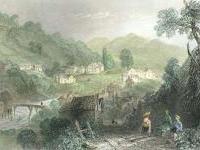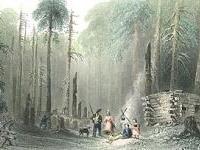 So who was waiting for Daniel Way and his young family in Canada after 1816? Remember the Gustin, the Mack and the Miller men from Marlow N.H., who were married to Esther, Ethelinda and Sally Way, Daniel’s aunts? In The History of Stanstead County, B. F. Hubbard writes that as early as 1799, John Gustin Jr and other companions trekked north along the Connecticut River, then west to an area in Stanstead Township near the shores of Lake Memphremagog.
So who was waiting for Daniel Way and his young family in Canada after 1816? Remember the Gustin, the Mack and the Miller men from Marlow N.H., who were married to Esther, Ethelinda and Sally Way, Daniel’s aunts? In The History of Stanstead County, B. F. Hubbard writes that as early as 1799, John Gustin Jr and other companions trekked north along the Connecticut River, then west to an area in Stanstead Township near the shores of Lake Memphremagog.
Having brought apple seeds, these men planted them in the hope that some day, fine orchards would be produced. The explorers went back to their families and friends in Marlow in the fall of that same year, but did not stay long. In March 1800, they headed back to the Stanstead area with a two-horse team, farming implements and other essentials. There they put up a shanty, and having purchased a yoke of oxen, a cow and a grindstone which they shared, each pioneer started a clearing of his own on the wooded lot that he had drawn for himself amongst the unclaimed parcels of land.
After having built a log cabin on one of the lots, the companions returned to Marlow in the fall of 1800. Then in 1801, John Gustin Jr went back to the Stanstead area and built his own log cabin. He returned to Marlow one last time. In February 1802, he moved to the Stanstead area for good with his wife Esther Way and their young children. In 1804, Ira Miller brought his children and wife Sally Way to their new home. Silas Mack followed suit in 1806 with his wife Ethelinda Way and their children.
From the young age of 5, Daniel Way must have heard the stories of exploration and discoveries, the tales of hardships and those of success that must have been told by his uncle John Gustin Jr and his companions when these men came back from Stanstead Township to spend the late fall and early winter with their families between 1799 and 1806 in Marlow. And while his uncles were away, Daniel may well have listened to his aunts discuss and plan their families’ inevitable move to the North. Much to fire the imagination of a small boy of 12 by the time his aunt Ethelinda and uncle Silas Mack had left New Hampshire for good in 1806!
 It is most likely Silas Mack and his wife Ethelinda Way who welcomed their nephew Daniel Way and his family into Canada sometime after 1816, in a settlement the pioneering uncles named after their homestead in New Hampshire: Marlow! In 1820, Daniel Way became a land owner in his own right, having bought a parcel of land on Lot 9, 7 th Range of Stanstead Township from his uncle Silas. Daniel started his new life in Canada farming his land and possibly helping his uncle Silas operate grist and sawmills known at the time as Mack’s Mills, at a place where Griffin Road met the Barlow River, now called the Tomifobia. Later on it would be called Comstock’s Mills. It was situated a mile upriver from Smith’s Hollow, a village later known as Smith’s Mills, and since 1918, Tomifobia.
It is most likely Silas Mack and his wife Ethelinda Way who welcomed their nephew Daniel Way and his family into Canada sometime after 1816, in a settlement the pioneering uncles named after their homestead in New Hampshire: Marlow! In 1820, Daniel Way became a land owner in his own right, having bought a parcel of land on Lot 9, 7 th Range of Stanstead Township from his uncle Silas. Daniel started his new life in Canada farming his land and possibly helping his uncle Silas operate grist and sawmills known at the time as Mack’s Mills, at a place where Griffin Road met the Barlow River, now called the Tomifobia. Later on it would be called Comstock’s Mills. It was situated a mile upriver from Smith’s Hollow, a village later known as Smith’s Mills, and since 1918, Tomifobia.
Marlow is not on any map. But go for a drive or a cycle on a nice day and from Beebe, follow the 247 East out of town. Turn left on Davis Rd, then left on Marlington Rd and right on Lamarche Rd. Stop! This is where the Marlow settlement thrived, where the first orchards flourished. Walk amongst the gravestones of Marlington Cemetery, one of the oldest burying grounds in Stanstead Township. Read the names of John Gustin, who died November 26, 1841; his wife Esther (Way), April 14, 1837 at the age of 66; Silas Mack, who died May 13, 1853; his wife Ethelinda (Way), July 10, 1848, at 68; Ira Miller, who died November 24, 1841; his wife Sally (Way), March 27, 1859, 81 years of age. Men and women who no doubt inspired a young and enterprising Daniel Way in the early 1800s to come and settle here.
To be continued...